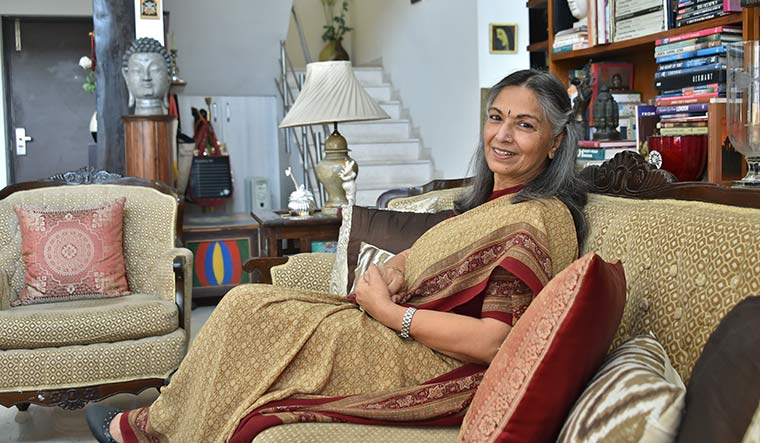When a man has become educated, he enters the householder stage of life... using money that he has inherited, on the one hand, or obtained from gifts, conquest, trade or wages. He settles down in a city, a capital city, a market town or some large gathering where there are good people, or wherever he has to stay to make a living. And there he makes his home near water, with an orchard, separate servant quarters, and two bedrooms.”
—Kamasutra by Vatsyayan
A “Google search for “Kamasutra” threw up 4.67 crore results in 0.57 seconds. (It was 1.09 crore for “Bhagavadgita”.) The first result—a website named SexPositions.Club—highlighted the “245 Kamasutra positions with pictures”. The right side of the screen advertised Richard Francis Burton’s translation of Vatsyayan’s Kamasutra. Notwithstanding the easy and free availability of more graphic, lurid and sexual content on the internet, the Kamasutra is back with a bang. Even the US Library of Congress lists 229 versions in its online catalogue!
There is new interest in the ancient Indian treatise that goes beyond the countless impossible positions of sexual intercourse. It touches the Kamasutra’s less known contents—on life and living. It is being rediscovered for what it says about lifestyle—like aesthetics and material transformation—and liberalism, including ethical transformation.
The Kamasutra, which is around 2,000 years old, has reappeared in modern times in many forms. A notable example is the tenth century erotic sculptures in the Khajuraho temples in Chhatarpur, Madhya Pradesh—a popular tourist destination and a UNESCO World Heritage Site. Then there are books based on the original treatise and exhibitions inspired by it. Readers and viewers are lapping them up for the new linkages being made with the ancient.
According to mythologist Devdutt Pattanaik, only 20 per cent of the Kamasutra is about “rati krida or erotic activity”. The remaining 80 per cent is about relationships. He says it is quite boring and reads like it may have been written by an engineering student. “It is not an erotic book; it is a scientific treatise,” said Pattanaik. “It is not about bhog (enjoyment), it is about contemplation.” Retired diplomat A.N.D Haksar presented his translation of Vatsyayan’s original in 2011 as “an essential part of the well-founded education of a young, urbane gentleman”.
Indologist and trained culturist Urmi Chanda doubts whether the Kamasutra would be considered ‘timeless’ if “the acrobatic sex and gimmicky bits” were to be removed. “Because then what would remain would be a guidebook for pleasurable living,” said Chanda. “As Gurcharan Das explains in his book Kama: The Riddle of Desire, the Kamasutra teaches its reader the art of pleasure—all manner of pleasure. It could be even gastronomic or aesthetic. It is, for the lack of a better term, a manual for the urban hedonist.”
Perhaps, the “contemplation” and “pleasurable living” parts of the ancient work are finally beginning to get noticed. Das’s fictional memoir, published in 2018, focuses on the fallout of chasing a life of pleasure. At its centre is the idea of human dilemma, and how his protagonist Amar deals with it. Amar has slogged hard and climbed the corporate ladder, he has worked on his marriage and raised his children. When he gets to his 40s, the fire in the bed is missing. He meets a beautiful co-passenger in the Deccan Queen on his way to Pune. They could very well have an affair, but should he? He is torn—no less than Prince Hamlet of “to be or not to be” fame.
His thoughts: It will destroy my marriage. I love my wife. I cannot hurt her. She will be devastated. What about the children, they will be hurt. But then the children will go away.... May be I should keep this affair a secret. But then if I keep it a secret, I will have to tell lies, lies upon lies, and that is not a good way to live. Das’s Amar has other questions troubling him, too: But what if I do not have an affair? Then what is the downside? If I do not have an affair, I will become a disgruntled person, resent myself, I may become a shrivelled, mean old man.
At the launch of his book, Das said: “We are going through a phase where we have a clash between the kama (sexual desire) optimists who are the young people whose minds got liberated after 1991, and the kama pessimists, the Hindu right, who do not have a knowledge of our liberal past when it comes to kama.” The reference to 1991 is because of the economic liberalisation that brought with it a fair amount of prosperity and a never-seen-before aspiration level. And while the Hindu right has always been there, it has moved from the background to the forefront in the last few years.
It was in August 2015 that Akshita Chandra, a designer at Locopopo Design Studio, Mumbai, read about 13 couples who were held by the Mumbai police for “indecent behaviour in public places”. They were arrested from some hotels in Madh Island and the Aksa area. They were all consenting locals who had checked into hotels. Chandra was then a student of the Srishti Institute of Art, Design and Technology in Bengaluru. The shocking news of moral policing came to her mind a few months later when she had to do a project linking the old to the new. “We had a project called Project Past in my last year of college wherein we were asked to use any part of history,” said the 24-year-old. “I wanted to work with censorship and moral policing as a topic, as our cultural past celebrated sexuality.”
As she researched for the project, she found that in May 2013, Ritu Tawade, a corporator of the Brihanmumbai Municipal Corporation, had said mannequins displaying lingerie were corrupting young minds. She also read that in 1979, artist F.N. Souza’s handwritten manuscript of his autobiography and 62 drawings he had sent from the US to India were impounded by the customs department on grounds of they being obscene. Souza had asked the officer whether he would be confiscating illustrations if they had been from the Khajuraho temples.
She contrasted all these bits of information with the liberalism that the sculptures of Khajuraho oozed. Her interactive works at the exhibition were well received by peers, the faculty, family and many others. Some admired her courage for it, though the usual suspects thought it was too obscene. “It was also flagged for adult content on the portfolio website Behance, which I found quite ironic and funny,” said Chandra.
She doubts if people know anymore about the Kamasutra other than the sex poses “because that is the only aspect of it that is publicised”. She said that was true for even the Khajuraho temples. “The erotic sculptures make up barely 10 per cent of the art, but that always get all the attention,” said Chandra.
Said Urmi Chanda: “We (Indians) are still struggling to adopt the pleasure-seeking, self-centric capitalist life without guilt, because the Southeast Asian ethos is intrinsically other-centric.” We are taught to place the larger good before the good of the self, she said, and this causes conflict when we set out to do the opposite. “The Kamasutra is useful in giving us validation from our own culture, reminding us that it is okay to want to please ourselves occasionally,” said Chanda, who among other things, is also a researcher for a proposed historical web series for Netflix.
Feminists are hailing the Kamasutra as evidence that India has been a feminist nation (if India 2,000 years ago can be called a nation). Jaya Misra, author of Kama: The Story of The Kama Sutra—published in April 2018—sees the Kamasutra through the prism of feminism and hails Vatsyayan as India’s first feminist. “In an environment post the Vedic period, where learned men refused to acknowledge that women could orgasm, that what could not be ejaculated, did not exist, here was a man with his pulse on the female desire,” she wrote in an imagined story on how a confirmed celibate may have cracked it.
While that it may be, Chanda said beyond women “opening up to sexual experiences and conversations about it, it is interesting to ask ourselves whether anything has changed fundamentally about our patriarchal mindset”. It is anyone’s guess, she said, referring to the Sabarimala case close on the heels of #MeToo movement.
Mythologist and narrative practitioner Seema Anand’s 2018 book, The Arts of Seduction, said “Vatsyayan did what no one had ever done before—he broke the ultimate gender myth”. According to Anand, for centuries religious belief had held that a woman did not have an independent source of pleasure, that her pleasure depended on that of the man. In other words, a woman’s orgasm was the result of a man’s. “The Kamasutra stated that not only do women have an independent source of pleasure but that a man is not even necessary to the process,” said Anand. “This belief was so controversial at the time that it created a huge stir; more importantly it put the work on the map for all time.”
It has long been believed among scholars of Hinduism, Tantra, mythology and ancient Indian culture, that the Kamasutra acquired the limited viewing of sex-position fixation once it was translated into English.
Soon after American scholar Wendy Doniger and Sudhir Kakkar translated the Kamasutra in 2002, Doniger said: “Most people do not read the Kamasutra. They just think it is a book about the sexual positions, a kind of dirty joke. In fact, there is a very brief section on the sexual positions, the rest of it is about a lot of other things. It is an awfully clever book.” Doniger elaborated that it is about the whole world of pleasure. “So it is about food and soft moonlight and good music and flowers strewn all over the bed room. It is also about meeting people, how you meet someone you are going to marry, how you meet someone you are not going to marry, how you deal with a married woman or a married man, and so forth. It is about the whole web of interpersonal relationships, which has an erotic basis.”
Doniger blamed Burton for sexing up the book. His first privately published edition was printed in 1883, restricted to 250 copies, and sent to subscribers in seven parts, each superscribed with the words, “for private circulation only”. Doniger’s Redeeming the Kamasutra (March 2016) was meant to bust the myth that the Kamasutra was primarily about positions, as was made out by Burton.
Doniger maintained that the text had “surprisingly modern ideas” about gender and “unexpectedly subtle stereotypes” of feminine and masculine natures. “It also reveals relatively liberal attitudes to women’s education and sexual freedom, and far more complex views on homosexual acts than are suggested by other texts of this period,” she said.
The books that are hitting the stands now are cleansed of what Anand described as “the fog of prevailing attitudes and the mire of mistranslations”. Shorn of that sexual positions slant, the Kamasutra that people are now seeing is all about the pleasures of life and living.
Incidentally, the Kamasutra also talks about grooming—of men as much as women— and skilling. “The 64 skills of the Kamasutra are the equivalent of a modern day finishing school for men and women,” said Anand.
Goldy Malhotra, an artist and actor, who has been principal of Delhi’s Modern School, Vasant Vihar, said that so much of what we are trying to teach boys and girls, particularly post the Nirbhaya case, is all there in the Kamasutra, making it relevant for our times. “Vatsyayan talks about psychological tenderness when boys and girls meet—boys are taught how to approach girls, girls are guided on how to respond, all this through a messenger,” said Malhotra. “Now what we are teaching—the good touch and the bad touch—is there. It is a householder’s compendium, talking about home management, entertainment, daily life, personal hygiene and balanced food.” Malhotra said she would recommend the many books on it to teachers who can take out relevant portions for different age groups.
It was many years ago when Malhotra played Vasantasena—the heroine of Shudraka’s Mrichchhakatika, written about the same time as the Kamasutra—that she first realised that there was more to the treatise than the sexual poses. “In spite of their erotic sculptures, the Khajuraho temples and the Konark temple have the garbhagraba (sanctum sanctorum) and the parikrama (moving clockwise around the idol). The same is true of the Kamasutra,” she said. Malhotra added that we are now discovering the real part of the ancient treatise.
Amar’s dilemma—on whether to have an extramarital affair or not—may be that of many young upwardly mobile Indians, making Das’s book on the battle between kama pessimists and kama optimists valuable.




